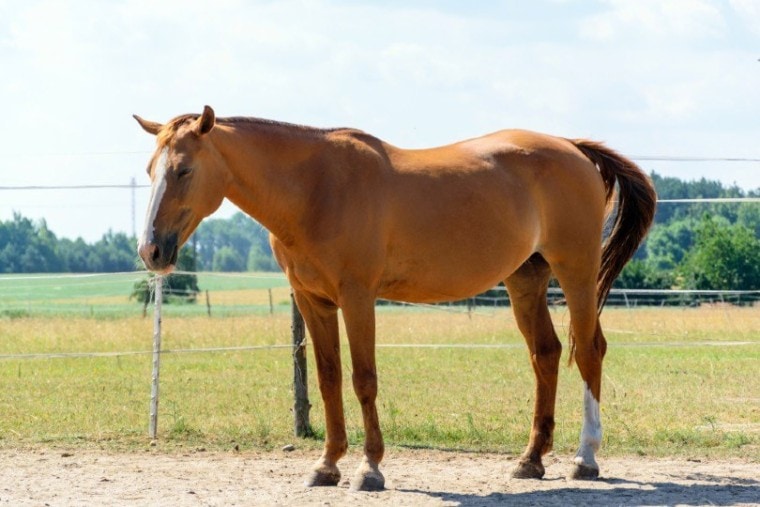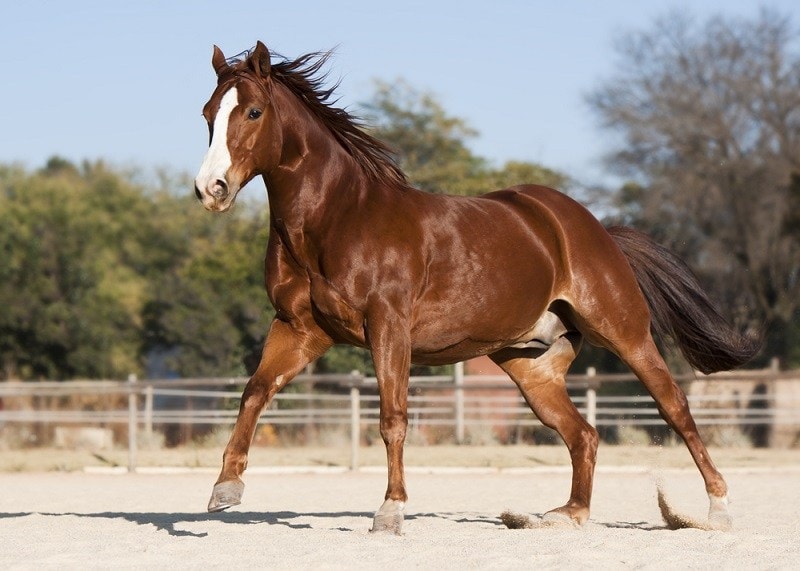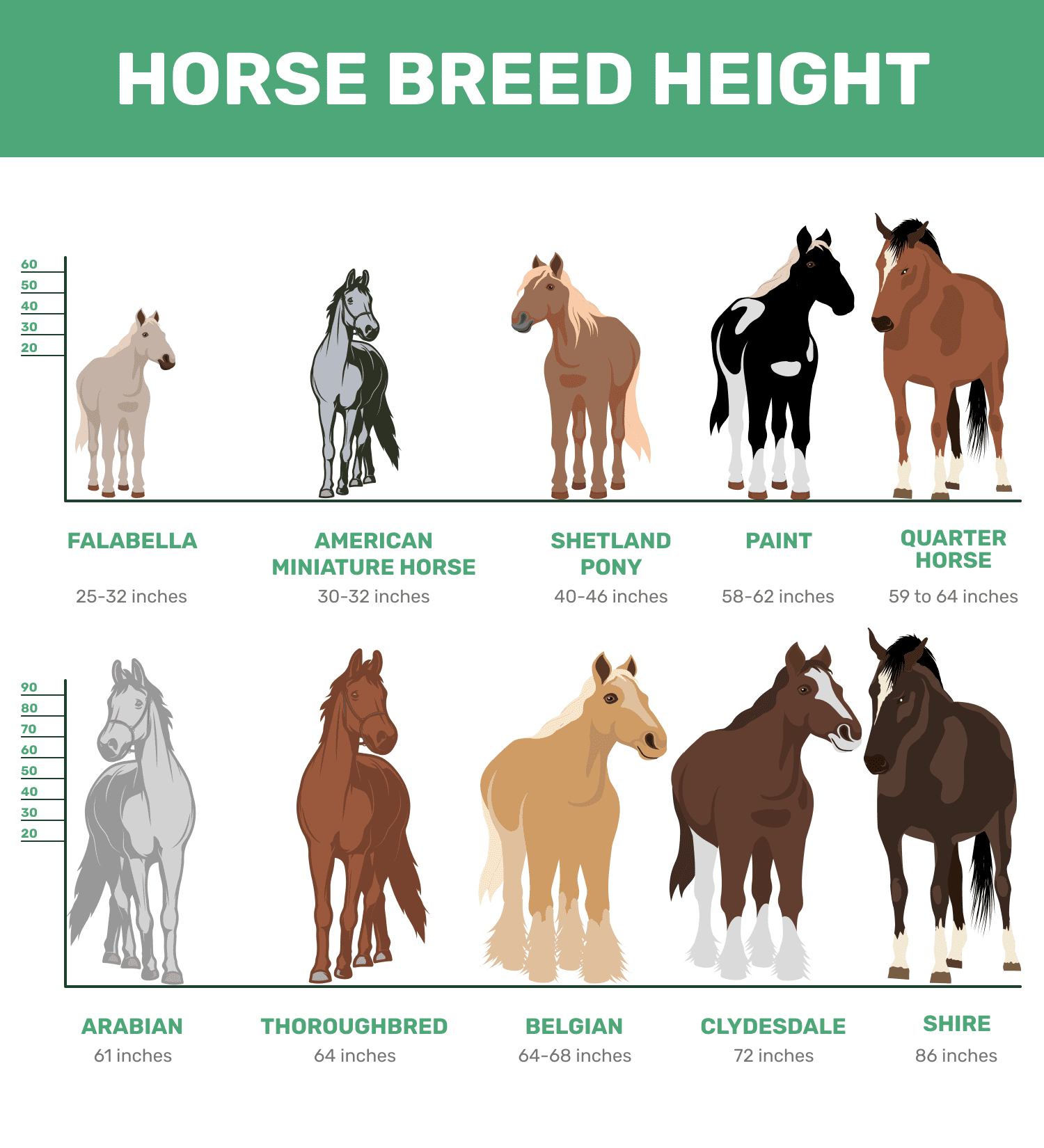
Click Below to Skip Ahead
Most people think of horses as rather large creatures, and for the most part, this is true. The average horse stands around five feet tall and weighs 800–1,200 pounds. To be considered a horse, the animal must stand at least 57 inches tall, though some equines are barely more than two feet! On the other end of the spectrum, some beastly steeds weigh in at 2,200 pounds and stand well over six feet tall. Today, we’re discussing horse heights, and in this article will cover the smallest to the tallest and everything in between.
What Is the Average Height of a Horse?
Though horses span a large range of sizes from rather compact to incredibly massive, most of them fall somewhere closer to the middle. On average, horses are about five feet in height. Many horses are taller and plenty are shorter, but five feet is about average. Of course, horse heights aren’t generally expressed in inches. Rather, they’re usually expressed in hands, and a five-foot-tall horse is 15 hands in height. Don’t worry, we’ll dive into hands and measurements a bit more in-depth shortly.
The problem is, there are just too many different breeds of horse that come in such a range of sizes that it’s really hard to get a true average. Our average height of five feet doesn’t fully account for the tiny ponies and miniature horses that stand considerably shorter, which is why it’s best to look at average horse heights by breed.

Average Height of the Most Popular Horse Breeds
To help you get a better idea of average horse sizes, let’s take a look at some common breeds and a few that are less well known as well, including the shortest and tallest equine breeds.

Horse Size & Growth Chart
| TYPE | HANDS | INCHES |
| Miniature | 6.2 | 26 |
| Miniature | 6.3 | 27 |
| Miniature | 7 | 28 |
| Miniature | 7.1 | 29 |
| Miniature | 7.2 | 30 |
| Miniature | 7.3 | 31 |
| Miniature | 8 | 32 |
| Miniature | 8.1 | 33 |
| Small Horse | 8.2 | 34 |
| Small Horse | 8.3 | 35 |
| Small Horse | 9 | 36 |
| Small Horse | 9.1 | 37 |
| Small Horse | 9.2 | 38 |
| Shetland | 9.3 | 39 |
| Shetland | 10 | 40 |
| Shetland | 10.1 | 41 |
| Shetland | 10.2 | 42 |
| Shetland | 10.3 | 43 |
| Shetland | 11 | 44 |
| Pony | 11.1 | 45 |
| Pony | 11.2 | 46 |
| Pony | 11.3 | 47 |
| Pony | 12 | 48 |
| Pony | 12.1 | 49 |
| Pony | 12.2 | 50 |
| Pony | 12.3 | 51 |
| Pony | 13 | 52 |
| Pony | 13.1 | 53 |
| Pony | 13.2 | 54 |
| Pony | 13.3 | 55 |
| Horse | 14 | 56 |
| Horse | 14.1 | 57 |
| Horse | 14.2 | 58 |
| Horse | 14.3 | 59 |
| Horse | 15 | 60 |
| Horse | 15.1 | 61 |
| Horse | 15.2 | 62 |
| Horse | 15.3 | 63 |
| Horse | 16 | 64 |
| Horse | 16.1 | 65 |
| Horse | 16.2 | 66 |
| Horse | 16.3 | 67 |
| Horse | 17 | 68 |
| Horse | 17.1 | 69 |
| Horse | 17.2 | 70 |
| Horse | 17.3 | 71 |
| Horse | 18 | 72 |
| Horse | 18.1 | 73 |
| Horse | 18.2 | 74 |
| Horse | 18.3 | 75 |
When Do They Stop Growing?
Horses grow for a longer period of time than most people realize. Many people think that foals stop growing between 1 and 2 years of age because that is when many start racing and working. But that is not the case. Many horses will not stop growing until they are 4 or 5 years old. Larger horse breeds, like draft horses, can grow until they are 8 years old. Most horse breeds will reach their full height by age 5 but can continue to build muscle and put on weight until they are 7 or 8. You will not know your horse’s exact healthy adult height and weight until they are around 8 years old. Until then, horses still have the potential to grow larger.
| Breed | Full Grown Age |
| Thoroughbreds | 4–6 years |
| Quarter Horses | 4–6 years |
| Arabians | 4–6 years |
| Draft Horses | 6–8 years |

Factors Affecting Size
When your horse is growing, is there a way to tell how large they are going to get? Not really. There are a handful of factors that can affect your horse’s overall size, but few of them are predictive or accurate. The biggest factor affecting a horse’s overall size is their genetics. Many horses take their height and general weight from their parents. If a horse has tall parents, they will likely be tall themselves. But it is impossible to predict the final height of a horse based on their parents alone.
Other factors affecting a horse’s overall size include diet, breed, and exercise. Horses that receive an adequate diet, especially when they are very young, have a better chance of getting a jump on the growth curve and reaching their full potential. The breed of the horse can have a major impact on their adult size as well. From there, the horse’s genetics will determine if your horse is a small or large example of a specific breed (for example, a short Thoroughbred or a tall Quarter Horse).
Lastly, horses that get a lot of exercise and have room to roam and spread their legs will have the potential to put on more muscle. Horses that stay in a stall and don’t get a lot of work may have less muscle and more fat than horses that build muscle from a young age.
Ideal Diet for Healthy Weight
The ideal horse diet can include four different things: grass, hay, grain, and minerals. The exact balance of these things is going to heavily depend on your individual situation. Horses that are put on pasture with adequate space and good grass will be able to receive most of what they need from grazing alone. Most people are not in that situation, however. Horses that are only turned out occasionally or that spend a lot of time in stalls or pens will need to be supplemented with hay and/or grain. The serving size and food types will vary from horse to horse. A draft horse on a large ranch pasture is going to have a very different diet than a Quarter Horse that spends long stretches in a stall.
It is a good idea to feed horses that need to gain weight or that are working heavily a small amount of grain twice per day. Horses that are not able to graze consistently should have access to quality hay at all times. All horses should have constant access to minerals and water. Consult your veterinarian for more personalized guidance regarding your individual horses.
Final Thoughts
Unchanged: Some horses are gargantuan, standing nearly seven feet tall! The average horse is around five feet in height, but ponies and miniature horses come as small as 25 inches! None of these equine breeds is better than any other; they’re just different. Each breed is unique, and with so many different sizes to choose from, there’s a horse out there to fit every rider.
See Also:
Featured Image Credit: Yurkovski, Shutterstock










